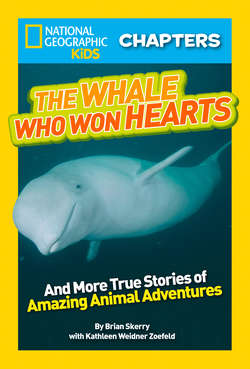Читать книгу National Geographic Kids Chapters: The Whale Who Won Hearts: And More True Stories of Adventures with Animals - National Kids Geographic - Страница 6
Оглавление
It was a warm night in May. I was walking along a beach in Trinidad (sounds like TRIH-nuh-dad), an island in the Caribbean (sounds like CARE-uh-BEE-un) Sea. It was almost midnight. The ocean waves rumbled and crashed onto the sand. Behind the beach, palm trees swayed in the damp breeze.
Suddenly, a few yards down, I spotted dark shapes on the sand.
Did You Know?
The temperature inside a leatherback’s nest determines if the baby turtles will be male or female.
They looked like huge rocks. But they were leatherback sea turtles! They were here to do something sea turtles have been doing for more than 100 million years. And I was hoping to shoot them. With my camera, that is!
My name is Brian Skerry. I’m an underwater wildlife photographer. It’s my job to take pictures of animals that live in the sea.
I fell in love with the sea when I was a child. I grew up in a small town in Massachusetts. We lived about an hour’s drive from the ocean. I was always asking my parents to take me there.
When I wasn’t at the beach, I was reading books or watching TV shows about ocean life. I really admired the sea turtles. It was fun to imagine gliding with them through miles of deep, blue water.
When I was 15, I tried scuba diving. It was in my family’s swimming pool. I was sitting in the shallow end. I had the scuba tank on my back. Hoses attached to the tank would bring air to my mouthpiece. I’ll never forget putting that mouthpiece in and taking my first breath underwater. All I could think was, “Wow! I have discovered a whole new world!”
As I grew up, I practiced diving. I studied photography in college. I began taking underwater photos. Finally, I landed my dream job. I was hired to take photos for National Geographic magazine. And that’s what brought me to Trinidad. I was there to photograph sea turtles for National Geographic.
Sea turtles are reptiles. Like all reptiles, they breathe air. But unlike most reptiles, sea turtles don’t live on land. They spend nearly their entire lives in the ocean. That’s why they’re called marine reptiles.
One hundred million years ago, dinosaurs ruled the land. At that time, many types of marine reptiles lived in the oceans. Giant, long-necked plesiosaurs (sounds like PLEEZ-ee-oh-soars) and sharp-toothed ichthyosaurs (sounds like ICK-thee-oh-soars) swam the seas. Earth’s first sea turtles swam with them.
Dinosaurs died out 65 million years ago. Marine reptiles went extinct then, too—all of them except for sea turtles, that is.
Seven types of sea turtles are still around today. The leatherback is the largest of them all. Leatherbacks can grow to more than seven feet (2 m) long. They can weigh more than 2,000 pounds (900 kg).
Other types of sea turtles have hard shells. Not leatherback sea turtles. They have thick, leathery skin. It’s what gives them their name.
My assistant Mauricio (sounds like moh-REE-cee-oh) Handler was with me on the beach. As we watched, the giant female leatherbacks began to dig their nests and lay their eggs. Female leatherbacks always lay their eggs on warm, sandy beaches. Usually they return to the same beach where they were born.
Sadly, leatherback turtles are in danger of extinction. People have been hunting leatherbacks for centuries. But over the past 30 years, too many have been killed for their meat. People raided nests and took all the eggs. Today, new laws help protect nesting leatherbacks and their eggs. But they still face many dangers. They get tangled in fishnets. They get hooked on longlines meant to catch large fish. Houses and hotels have also been built on some of the leatherbacks’ favorite nesting beaches.
I moved in close to one of the turtles. Leatherbacks only come out when it is dark. I knew the camera flashbulb would disturb her. So I would rely on the moonlight.
The turtle found a spot she liked. She made a shallow pit in the sand with her front flippers. Once she was comfy, she dug a deep hole with her hind flippers. She took long, deep breaths as she dug. To me, it was like a sound from the prehistoric (sounds like pre-hih-STORE-ick) past! She laid more than 80 round, white eggs in the hole. Then she covered them with sand.
We watched as the turtle headed back to the water. Having a chance to photograph this huge creature in the wild was thrilling—almost like seeing a living dinosaur!
A newly hatched baby leatherback scurries to the sea. It will spend the rest of its life in the water.
